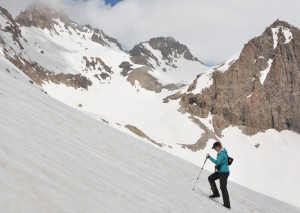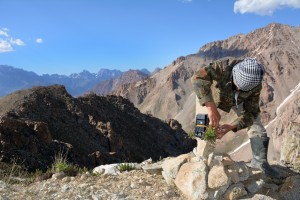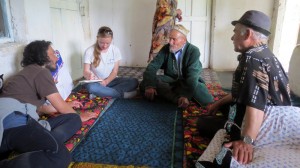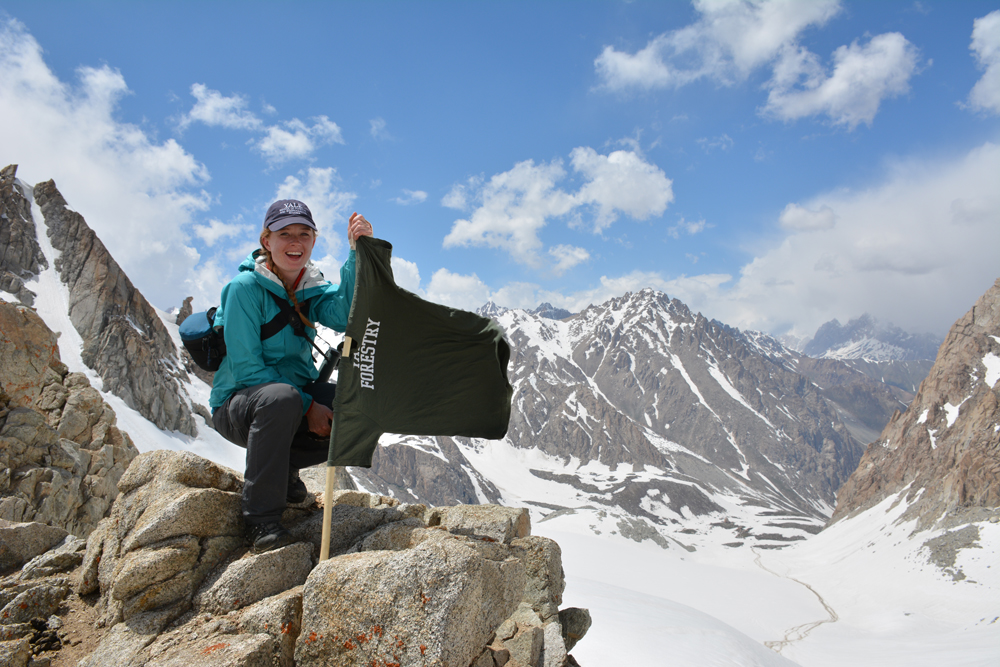“Excrement! Excrement!” Komil shouted excitedly, but a powerful wind carried his shouts over the precipice and down toward the valley a thousand meters below. Unable to hear him over the approaching storm, I scrambled down the ridge to where he was pointing and there I saw it: a nice, big, chalky pile of snow leopard poop. My research assistant and I were on Moura Pass, which, at 3870 meters high, connects two vital summer grazing areas for livestock in Tajikistan’s Hissar Mountains. Dark clouds shuffled over snow-covered peaks, surrounding us as far as the eye could see. But the storms were a distant thought as we danced and cheered above our small but significant discovery. After two weeks of rigorous fieldwork, we had finally found our first real sign of the species: a scat sample for DNA analysis. More importantly, we were closer to potentially confirming the presence of the snow leopard, also known as the “ghost cat” because of its extreme elusiveness, which most people had told us we would not find.

I came to the Hissar Mountains on the suggestion of my collaborators at Panthera and the Department of Zoology in the Academy of Sciences, Republic of Tajikistan. Anecdotes from a few local hunters described the presence of snow leopards at high elevations, and Panthera and the Academy were interested in finding out if these stories were true. We hypothesized that the Hissar Mountain Range may provide essential genetic connectivity between the snow leopards in the Pamir Mountains in eastern Tajikistan and a recently confirmed population in Uzbekistan. However, when I arrived in Tajikistan, many people I interviewed said I was wasting my time (and money) thinking I could find snow leopards in mountains known for extensive livestock grazing and illegal hunting of ibex, one of the snow leopard’s major prey species. During our first week in the field, even one of my own research assistants told me we would not find any snow leopards here and that we should move our work to somewhere else. Despite these warnings and doubts, we decided to continue with our plan to use camera traps and fecal DNA analysis to survey for snow leopards in the Hissar Mountain Range.

My project began with a rocky start, but picked up with the arrival of my third assistant, Khalil. Our newly formed team of four knew that we would need photographic evidence to officially confirm the presence of snow leopards in these mountains. We also knew that to maximize our chances of capturing images of snow leopards, the placement of each camera was critical. Using old Soviet topographic maps, we marked potential camera location points roughly five kilometers apart near big rock faces above 3000 meters. Once in the field, we broke into two teams and each day climbed toward a new point on our map. We searched for flat ledges at the base of big rock walls, wide ridgelines, or mountain passes connecting high peaks – areas that looked like major thoroughfares for both snow leopards and ibex. We tried to climb as high as possible to minimize the risk of livestock herders or hunters finding and taking our cameras. We also looked for physical signs of snow leopards and ibex such as tracks, excrement, scrapes, or hair. The ideal place for a camera would have all of these elements, though we knew in areas where snow leopards are rare that “perfect” camera locations would be extremely difficult to find.

After our exhilarating discovery on Moura Pass, my three assistants and I continued our work with growing confidence. We climbed, camped, and savored the beauty of the southern slopes and valleys of the Hissar Range while placing the first 26 of my 40 camera traps and collecting eleven potential snow leopard scat samples. Along the way we also conducted interviews with local hunters and shepherds, who told stories of hunting ibex, marmots, bears, and even a snow leopard many years ago.
In Sioma, a valley where the water was so fresh and sweet we drank it straight from the mountain streams, I met a mountain man named Ivan whose knowledge of the region’s natural history and ecology was beyond compare. He described how some species, such as marmots and ibex, were slowly migrating up the mountainsides due to increased pressure from livestock grazing and poaching. He also showed us old slide photos of two different snow leopards, which he took nearly twenty years ago in the same area.

In our fourth week of fieldwork our team drove from Dushanbe through an unmaintained six-kilometer tunnel to Iskanderkul on the north side of the Hissar Range. Iskanderkul is a large, glacially formed lake named after Alexander the Great, and is said to be the place where his horse was buried. My team and I quickly finished placing our remaining fourteen cameras in this paradise. It would be a few weeks before we could start collecting our first cameras and results, as each camera needed to be in place for at least six weeks to maximize our chances of photographing the ghost cat. Now the waiting would begin.
Edited by Timothy Brown.